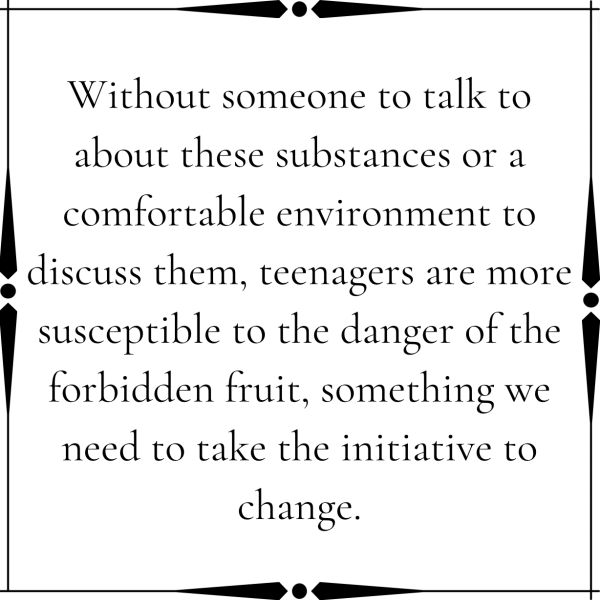As children, we were told not to go for the cookie jar, not to draw on the walls and not to eat dirt. Yet we did it anyway. There’s always been something alluring about being told what not to do and doing it anyway. As teenagers, what we can and can’t do has drastically changed from childhood, and we yearn for more control and independence in our lives. This feeling is often achieved through doing the things we’ve been denied for so long now that we have the freedom and ability to do so.
 Across the U.S., it’s not uncommon to drink underage, with a study by the National Institute of Alcohol and Alcohol Abuse revealing that about a third of underage Americans have had at least one drink. The older we get, the more tempting substances start to seem. Factors such as peer pressure also play into this, where young adults may feel like they need to lean into these activities in order to connect with their peers and feel accepted in new environments. As MVHS teenagers move on to college and begin to engage in partying culture more, these activities may feel like the only way to keep up with others and find community — it potentially heightens their social status and broadens their social circles.
Across the U.S., it’s not uncommon to drink underage, with a study by the National Institute of Alcohol and Alcohol Abuse revealing that about a third of underage Americans have had at least one drink. The older we get, the more tempting substances start to seem. Factors such as peer pressure also play into this, where young adults may feel like they need to lean into these activities in order to connect with their peers and feel accepted in new environments. As MVHS teenagers move on to college and begin to engage in partying culture more, these activities may feel like the only way to keep up with others and find community — it potentially heightens their social status and broadens their social circles.
These activities are then likened to the forbidden fruit so romanticized in the media. Forbidden fruit is something that is desired even more because it’s not allowed. Across campus, 68% of MVHS students share the impression that drinking or doing drugs is romanticized. The media often reinforces positive portrayals of teenagers and young adults engaging in drinking or substance use, with alcohol being correlated with a glamorous lifestyle or luxury and wealth. Drinking appears to be a privilege of adulthood that makes users feel sexy or mature. Despite the number one cause of adolescents experimenting with substances being exposure to other kids using drugs or alcohol, the urge to commit these crimes is everywhere — teenagers are more likely to see an ad for alcohol than a public service announcement discouraging it. One drinking scene is shown on TV every 22 minutes, with one illicit drug scene every 112 minutes. Over a third of these scenes actually portray alcohol use as comedic, while the negative consequences are only shown 23% of the time.
To ensure students don’t go to college with misguided mindsets surrounding these substances, we need to establish comfortability around open conversations about alcohol or drugs. As teens become increasingly curious about these activities, by creating a safe space where they can talk about them with parents or teachers, we are ensuring that they don’t attempt these by satiating teens’ curiosity and removing the forbidden allure. By talking directly with teenagers, this also helps create trust and mutual respect. If we treat the subject as something teenagers can be comfortable about approaching in conversation, we can more easily educate them and teach them about safe boundaries and possible dangers.
Once we graduate and go off to our various universities, access to substances increases drastically with about 50% of college students in the U.S. saying they could acquire alcohol if they wanted to. If students don’t know how to use them responsibly or don’t have prior education, it’s very easy to get hurt. Scenarios such as drugging drinks are unfortunately becoming more common, and will continue to happen if teenagers aren’t educated on how to avoid those situations. Without the knowledge needed to navigate these situations safely, youths are all the more vulnerable.
Although activities like drinking and drugs are less commonplace among MVHS students because of the uniquely competitive, school-focused environment, it is still present in private settings and something we need to keep in mind when considering education and future plans. Activities like drinking are considered taboo to talk about, but maybe they shouldn’t be. By avoiding painting them as forbidden fruit, we are better preparing these students for a future where they’ll face these things in less safe environments without a guardian’s supervision. Without someone to talk to about these substances or a comfortable environment to discuss them, teenagers are more susceptible to the danger of the forbidden fruit, something we need to take the initiative to change.










